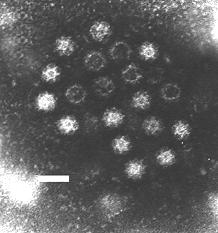Caliciviridae
(Redirected from Calicivirus)
Family of viruses
The Caliciviridae is a family of viruses that infect a wide range of hosts, including humans and animals. Members of this family are known for their small, non-enveloped, icosahedral structure and single-stranded RNA genome. The family includes several genera, with notable members such as the Norovirus and Sapovirus, which are significant causes of gastroenteritis in humans.
Structure[edit | edit source]
Caliciviruses are characterized by their small, round, non-enveloped virions, typically 27-40 nm in diameter. The capsid is composed of 180 copies of a single protein, arranged in an icosahedral symmetry. The surface of the virion displays a distinctive cup-shaped depression, which is a hallmark of the family and gives the family its name (from Latin "calyx" meaning cup).
Genome[edit | edit source]
The genome of caliciviruses is a single-stranded, positive-sense RNA molecule, approximately 7.4 to 8.3 kilobases in length. It is organized into three open reading frames (ORFs). ORF1 encodes a polyprotein that is processed into non-structural proteins, including the RNA-dependent RNA polymerase. ORF2 encodes the major capsid protein, and ORF3 encodes a minor structural protein.
Replication[edit | edit source]
Calicivirus replication occurs in the cytoplasm of the host cell. The virus attaches to the host cell surface receptors and is internalized. The viral RNA is released into the cytoplasm, where it is translated into viral proteins. The RNA-dependent RNA polymerase synthesizes a complementary negative-sense RNA strand, which serves as a template for the production of new positive-sense RNA genomes. These genomes are packaged into new virions, which are then released from the host cell to infect new cells.
Pathogenesis[edit | edit source]
Caliciviruses are known to cause a range of diseases in humans and animals. In humans, noroviruses are the leading cause of viral gastroenteritis, characterized by acute onset of vomiting and diarrhea. Sapoviruses also cause gastroenteritis, primarily in children. In animals, caliciviruses can cause diseases such as feline calicivirus infection in cats and rabbit hemorrhagic disease in rabbits.
Epidemiology[edit | edit source]
Caliciviruses are highly contagious and can spread rapidly in closed environments such as cruise ships, nursing homes, and schools. Transmission occurs primarily through the fecal-oral route, either by direct contact with an infected person or by consuming contaminated food or water. The viruses are resistant to many common disinfectants, which contributes to their ability to cause outbreaks.
Prevention and Control[edit | edit source]
Preventing calicivirus infections involves good hygiene practices, such as regular handwashing, especially after using the bathroom and before eating. In outbreak settings, thorough cleaning and disinfection of contaminated surfaces are crucial. Vaccines are available for some animal caliciviruses, such as the feline calicivirus, but there are currently no vaccines for human caliciviruses.
Related pages[edit | edit source]
Transform your life with W8MD's budget GLP1 injections from $125
W8MD offers a medical weight loss program NYC and a clinic to lose weight in Philadelphia. Our W8MD's physician supervised medical weight loss centers in NYC provides expert medical guidance, and offers telemedicine options for convenience.
Why choose W8MD?
- Comprehensive care with FDA-approved weight loss medications including:
- loss injections in NYC both generic and brand names:
- weight loss medications including Phentermine, Qsymia, Diethylpropion etc.
- Accept most insurances for visits or discounted self pay cost.
- Generic weight loss injections starting from just $125.00 for the starting dose
- In person weight loss NYC and telemedicine medical weight loss options in New York city available
- Budget GLP1 weight loss injections in NYC starting from $125.00 biweekly with insurance!
Book Your Appointment
Start your NYC weight loss journey today at our NYC medical weight loss, and Philadelphia medical weight loss Call (718)946-5500 for NY and 215 676 2334 for PA
Search WikiMD
Ad.Tired of being Overweight? Try W8MD's NYC physician weight loss.
Semaglutide (Ozempic / Wegovy and Tirzepatide (Mounjaro / Zepbound) available. Call 718 946 5500.
Advertise on WikiMD
|
WikiMD's Wellness Encyclopedia |
| Let Food Be Thy Medicine Medicine Thy Food - Hippocrates |
Translate this page: - East Asian
中文,
日本,
한국어,
South Asian
हिन्दी,
தமிழ்,
తెలుగు,
Urdu,
ಕನ್ನಡ,
Southeast Asian
Indonesian,
Vietnamese,
Thai,
မြန်မာဘာသာ,
বাংলা
European
español,
Deutsch,
français,
Greek,
português do Brasil,
polski,
română,
русский,
Nederlands,
norsk,
svenska,
suomi,
Italian
Middle Eastern & African
عربى,
Turkish,
Persian,
Hebrew,
Afrikaans,
isiZulu,
Kiswahili,
Other
Bulgarian,
Hungarian,
Czech,
Swedish,
മലയാളം,
मराठी,
ਪੰਜਾਬੀ,
ગુજરાતી,
Portuguese,
Ukrainian
Medical Disclaimer: WikiMD is not a substitute for professional medical advice. The information on WikiMD is provided as an information resource only, may be incorrect, outdated or misleading, and is not to be used or relied on for any diagnostic or treatment purposes. Please consult your health care provider before making any healthcare decisions or for guidance about a specific medical condition. WikiMD expressly disclaims responsibility, and shall have no liability, for any damages, loss, injury, or liability whatsoever suffered as a result of your reliance on the information contained in this site. By visiting this site you agree to the foregoing terms and conditions, which may from time to time be changed or supplemented by WikiMD. If you do not agree to the foregoing terms and conditions, you should not enter or use this site. See full disclaimer.
Credits:Most images are courtesy of Wikimedia commons, and templates, categories Wikipedia, licensed under CC BY SA or similar.
Contributors: Prab R. Tumpati, MD





